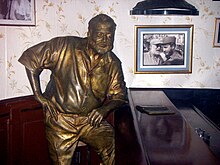José Villa Soberón
José Ramón Villa Soberón (born September 2, 1950 in Santiago de Cuba ) is a Cuban sculptor and art professor.
Life
In 1950 José Villa Soberón was born in Santiago de Cuba . He enjoyed his artistic training from 1965 to 1971 at the Escuela Nacional de Arte in Havana, then from 1971 to 1976 at the Academy for Sculpture in Prague. Since his return to Cuba in 1976 he has been teaching at the Instituto Superior de Arte in Havana , where he was Dean of the Faculty of Sculpture from 1986 to 1990. In the Cuban State Association of Artists and Writers (UNEAC), to which he has been a member since 1982, he was chairman of the sculpture division from 1993-2008 and has been the first deputy chairman of the association since then. Since 1982 he has been a member of the Cuban Committee of the International Association of Art .
plant

His copper statue of John Lennon sitting on a park bench in Havana is particularly famous . The sculpture was unveiled by Fidel Castro on December 8, 2000 . Since 2001, in front of the Convento de San Francisco de Asís in Old Havana, there has been a bronze statue of Caballero de París , a well-known, mentally confused man who roamed the streets of the city for years. In 2003, Ernest Hemingway was portrayed in the El Floridita bar , also in Havana, and in 2004 in Cienfuegos , Beny Moré , another monument to a legend of the 20th century. His earlier works were mostly abstract.
Another famous work is the Cruz Andina at El Alto Airport in Bolivia .
Web links
- Official homepage (Spanish or English)
- Álex Ayala: Los custodios de Lennon ( Memento of December 9, 2008 in the Internet Archive ), article on Soberón, in: La Razón of December 11, 2005 (Spanish)
- BBC to Lennon statue (English)
- José Villa Soberón in the official Cuban online encyclopedia EcuRed (Spanish)
Individual evidence
- ↑ Curriculum ( Memento of the original from April 12, 2015 in the Internet Archive ) Info: The archive link was inserted automatically and has not yet been checked. Please check the original and archive link according to the instructions and then remove this notice. (PDF), personal website, accessed April 8, 2015 (Spanish)
- ↑ José Ramón Villa Soberón, curriculum vitae on the government website Habana Cultural , accessed on April 8, 2015 (Spanish)
| personal data | |
|---|---|
| SURNAME | Villa Soberón, José |
| ALTERNATIVE NAMES | Villa Soberón, José Ramón |
| BRIEF DESCRIPTION | Cuban sculptor and art professor |
| DATE OF BIRTH | 2nd September 1950 |
| PLACE OF BIRTH | Santiago de Cuba , Cuba |
